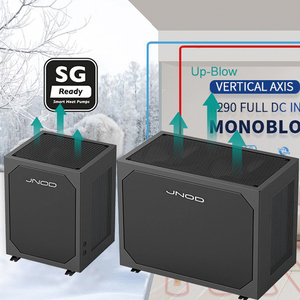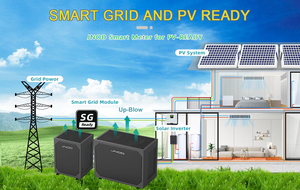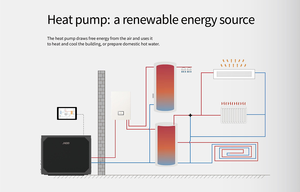
All categories
Featured selections
Trade Assurance
Buyer Central
Help Center
Get the app
Become a supplier

(121604 products available)




















 Ready to Ship
Ready to Ship
A home cooling system is an umbrella term for a range of products that are used to cool the temperature in a house. Several different types of home cooling systems are available, each with its own set of features and benefits.
This is typically the most common home cooling system. Central air conditioning devices use a mix of coils, refrigerant, and a compressor to cool the air. This cooled air is then distributed throughout the house through a network of ducts and vents. One of the major benefits of central air conditioning is its ability to cool the entire house simultaneously. However, it is also the most expensive type of cooling system to install and can lead to high energy bills.
These are self-contained devices that can be mounted in a window. They function by pulling in warm air, cooling it, and then recirculating the cooled air back into the room. Window air conditioners are more affordable than central air conditioning systems. They are also better for cooling small spaces rather than the whole house. However, they can be quite loud and block natural light from windows.
These are similar to window units but are free-standing and can be moved from room to room. Portable air conditioners are easy to install, and they don’t require a permanent mounting solution. They are great for cooling specific rooms or areas of the house. On the downside, they are generally less efficient than other cooling systems and often require a window or vent to be placed near.
They function similarly to central air conditioners, but they can reverse the process to provide heating in colder months. Air source heat pumps are energy efficient and can reduce both heating and ac cooling costs throughout the year. Nonetheless, they may not offer sufficient warmth in extremely cold climates.
Also known as swamp coolers, they cool the air through the evaporation of water. Evaporative coolers are very energy efficient and are eco-friendly options for cooling home spaces. They are more suited to dry climates and may not be effective in humid areas.
These systems have an outdoor compressor and an indoor air-handling unit, which is connected by a small conduit. Ac ductless unit mini-split systems are a great way to add air conditioning to homes without existing ductwork. They are also energy efficient and allow for zoned cooling. However, the installation can be expensive, and the indoor units may not be aesthetically pleasing.
The following specification and maintenance tips will help homeowners take care of their home cooling system:
Capacity: The bigger the house, the greater the capacity needed. One ton is equivalent to 12,000 British thermal units per hour. A 2,000 square-foot house needs a cooling capacity of between 2.5 and 4 tons.
Energy efficiency: The energy efficiency of an air conditioner unit for room is measured by its seasonal energy efficiency ratio (SEER). The higher the SEER rating, the more energy efficient the air conditioner.
Airflow: It is an important factor in determining the efficiency of the air conditioner. The air conditioner should have the right airflow to cool the home properly.
Humidity control: The air conditioner should be able to remove humidity from the air to make the home more comfortable. This is measured by the energy efficiency ratio (EER). A higher EER rating means better humidity control.
Clean or replace the air filters: Clogged filters block normal airflow and reduce the system's efficiency. Cleaning or replacing the air filters every 1-3 months will make the system work better.
Clean the evaporator and condenser coils: Dirty coils reduce the cooling system's ability to absorb and release heat. They can be cleaned a few times a year to keep the system efficient.
Clean the drainage system: The system that allows the air conditioner to drain excess moisture must be clean. A clog can cause water damage, high humidity, and mold growth.
Check the refrigerant level: The right amount of refrigerant is important for the air conditioner to work properly. If the refrigerant is low, it means there is a leak that should be found and fixed immediately.
Seal and insulate the ducts: Leaky ducts reduce the cooling system's efficiency. Sealing and insulating the ducts will help ensure that the cool air reaches its destination.
Regular professional HVAC maintenance: A professional should check the home cooling system every year. They will inspect, clean, and tune up the system to ensure it runs safely and efficiently.
Home cooling systems are designed to provide indoor comfort by creating cooler and more favorable indoor environments. They have diverse applications in residential, commercial, and industrial settings.
In residential settings, cooling systems are used in single-family homes, townhouses, condos, and apartments. Homeowners rely on them to create comfortable indoor environments during hot weather. Common types of residential cooling systems include split AC systems, window air conditioners, portable AC units, and evaporative coolers. By installing these systems, homeowners and tenants can enjoy restful sleep, stay productive, and relax in cool indoor spaces.
Home cooling systems are widely used in office buildings, which are important public buildings that accommodate office work, meetings, and other activities. Keeping the office environment cool and comfortable can help improve employee productivity and job satisfaction. In addition to improving employee work efficiency, creating a comfortable office environment can also enhance the corporate image and attract potential customers during business negotiations and visits. Central air conditioning systems, split AC systems, and variable refrigerant flow (VRF) systems are common cooling solutions in offices.
Industrial facilities that produce large amounts of heat during manufacturing processes can benefit from effective cooling systems. Cooling systems help regulate the temperature of production areas, protect equipment from overheating, and ensure optimal working conditions for employees. Industrial buildings such as food processing plants, electronics manufacturing facilities, warehouses, and workshops all need to be equipped with effective cooling systems. Common solutions include industrial chillers, cooling towers, and spot coolers.
Public spaces, such as shopping malls, cinemas, libraries, museums, and transportation hubs, are frequented by people. The huge flow of people will produce a lot of heat, which makes the temperature in these areas higher. In order to ensure the safety and comfort of visitors, it is necessary to install an effective cooling system in these public spaces. Central air conditioning, room ac unit mini-splits, and ceiling fans are common cooling solutions in these areas.
In the hospitality industry, hotels, resorts, and restaurants need to create a comfortable and pleasant experience for guests. It is important to provide effective cooling solutions in guest rooms, lobbies, banquet halls, and other hospitality areas. Central air conditioning systems, heat pumps, and cooling fans are commonly used. Providing guests with a cool and comfortable environment can enhance their satisfaction and loyalty, thereby promoting the sustainable development of the business.
When selecting a suitable home cooling system, there are several factors to take into account. These include the size and layout of the home, the number of occupants, the existing infrastructure of the home, the budget, as well as the climate and weather conditions in the region.
It is important to choose an AC unit with an appropriate cooling capacity for the square footage of the home. While a window unit or ductless mini-split may provide adequate cooling for small apartments or individual rooms, a central air conditioning system may be more suitable for larger homes with existing ductwork. Investing in a smart thermostat can help regulate temperature and energy use, potentially reducing costs in the long run. Homeowners should also consider air quality when selecting a cooling system. Some units come with advanced filtration or humidity control features to improve indoor air quality.
Energy efficiency is another important factor to consider when purchasing a home cooling system. Home buyers are encouraged to look for units with a high SEER (Seasonal Energy Efficiency Ratio) rating, as this indicates better energy efficiency and lower long-term operational costs. Additionally, the type of refrigerant used by the cooling system is important. Certain refrigerants, such as R-410A or R-32, are more environmentally friendly than older alternatives like R-22, which is being phased out due to its ozone-depleting properties.
Homeowners should think about their long-term comfort and choose a cooling system that can be relied upon to perform well in a variety of weather conditions. Proper installation and routine maintenance are also crucial to ensure the cooling system functions efficiently and has a long operating life.
Q1. Why should a business buyer invest in a central cooling system?
A1. Central cooling systems are preferable for several reasons. They are more efficient than traditional air conditioning. The energy efficiency of the AC unit, as measured by the SEER (Seasonal Energy Efficiency Ratio) rating, is higher in central ACs. Moreover, central air conditioners tend to have a longer life span than window units. Central cooling systems also improve indoor air quality. They use air ducts to circulate filtered air throughout the building. This can help remove dust, pollen, debris, and other air pollutants that can cause respiratory problems. Finally, central cooling units are more aesthetically pleasing because they don't sit in the window or occupy space on the floor. This could also increase the value of the property.
Q2. What is the difference between a split system and a packaged system?
A2. Split and packaged central cooling systems work in the same way but are constructed differently. A split system consists of an outdoor unit with a compressor and condenser, as well as an inside evaporator coil and blower in the furnace. A split system with an air conditioner is combined with a forced air furnace with a heat pump. A packaged central cooling system has all of its components in one outdoor unit. The packaged air conditioner is usually placed on the roof or a concrete slab next to the foundation. It is connected to the ducts that distribute the cooled air through the building.
Q3. What are the benefits of a zoned home cooling system?
A3. A zoned home cooling system divides the home into zones that can be controlled independently. Each zone has its temperature settings. Zoned cooling systems are more efficient. They only cool areas of the home that are in use. They also reduce energy waste. Zoning can also improve comfort. Family members can select the temperature that suits them best. Finally, zoning can extend the life of the cooling system. Individual cooling zones can be shut down when not in use. This reduces the wear and tear on the system.